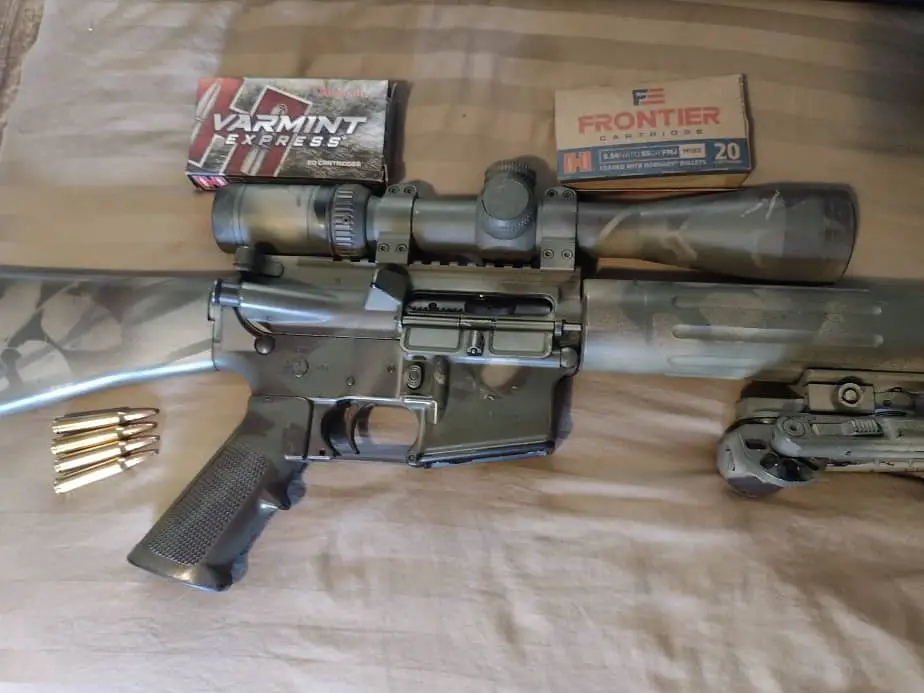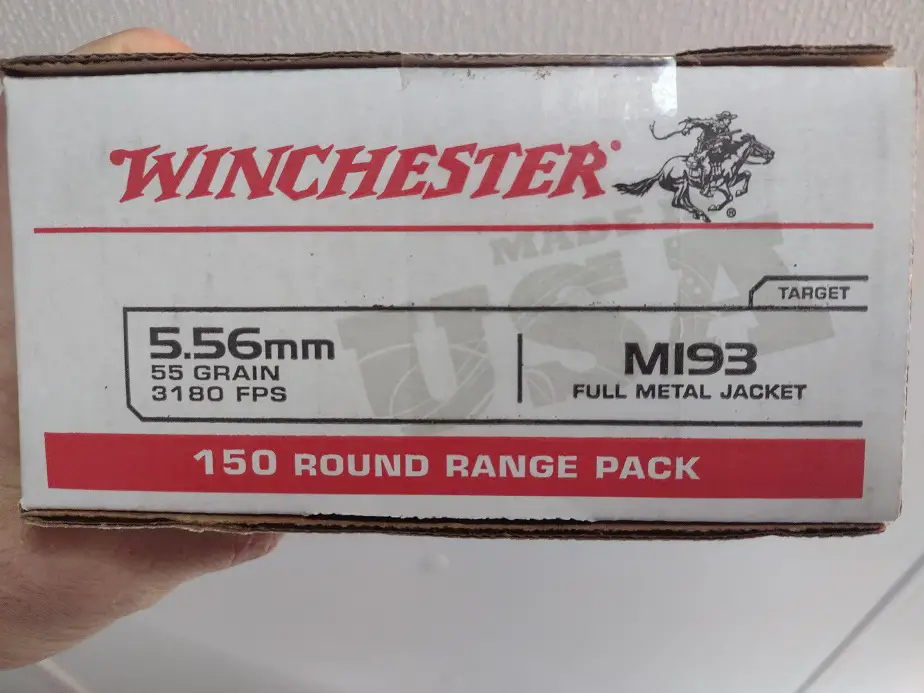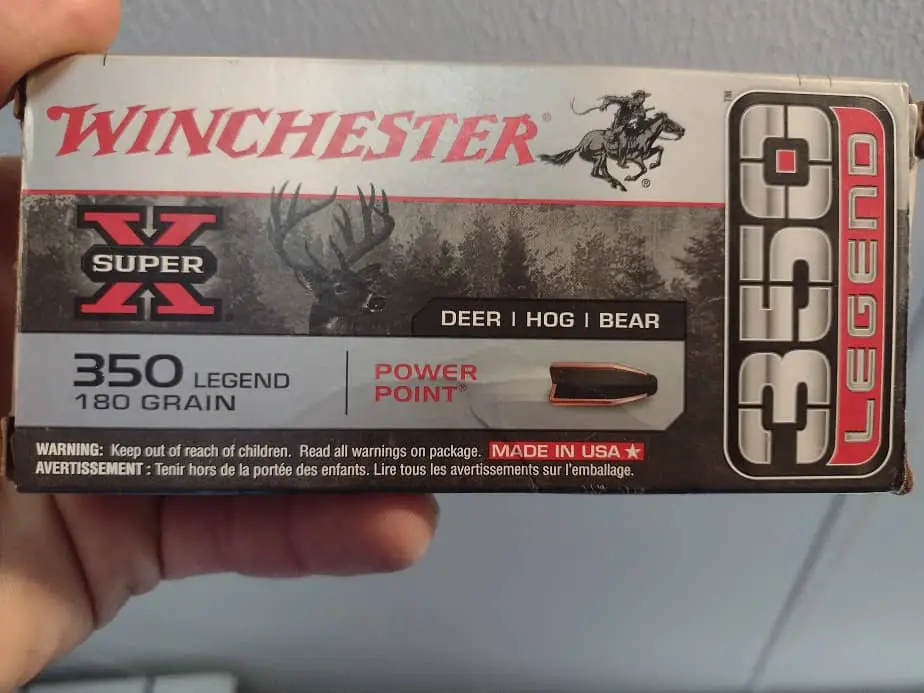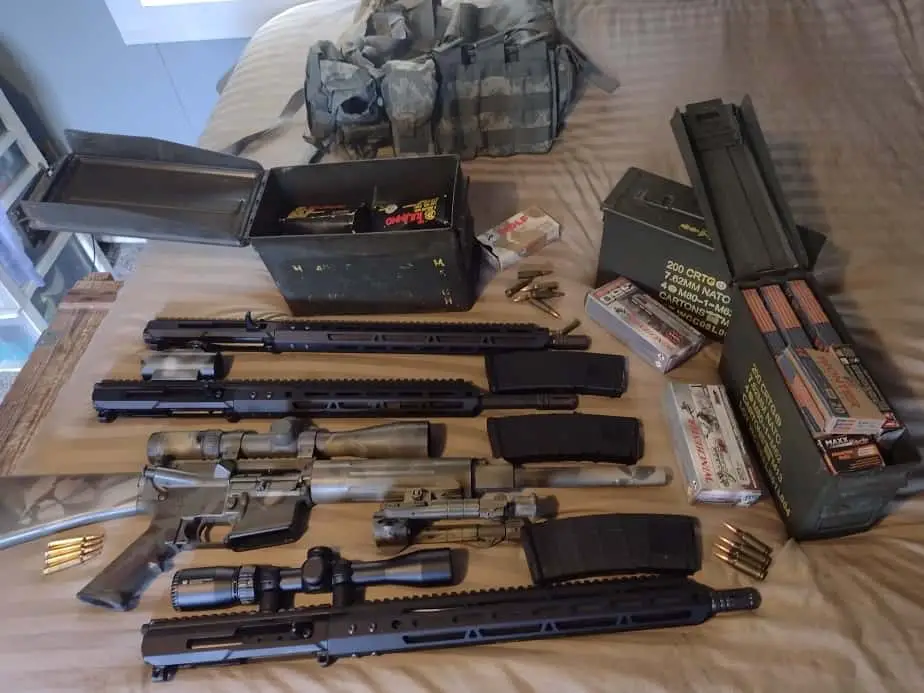I’ve worked with every commonly available caliber for the AR-15. Having done ballistics testing and close-quarters defensive training, I have some pretty solid recommendations.
The best AR-15 cartridge for home defense is the 5.56/223. It’s a low-recoil, cheap, and devastating caliber at close range, and has a low chance of over-penetration. But, AR-15 pistols perform better with the 350 Legend or 300-Blackout. The .223/5.56 and 350 Legend are both incredibly effective options for a defensive AR.
You probably figured the .223, but what about the other calibers? Why are they so great and what makes them a good choice? Let me show you.
The Best Caliber for a Defensive AR-15 Rifle
The overall best caliber for a defensive AR-15 rifle is the .223/5.56. Its Magazine capacity, reliable wounding capabilities, and moderate muzzle flash make it a good choice for most situations. Its high rate of fire and quick follow-up shots, plus the ability to be controlled by small people make it a particularly devastating weapon choice.
Now, there are other fine choices, but I have to put this one on top. Anyone could go buy a basic AR-15 off the gun store shelf chambered in .223/5.56 (either or) and a box of ammo, and be well-armed. It’s proved highly effective as a universal choice for a mid-range defensive/combat caliber.
You might be thinking it’s too small or unreliable to trust in. That’s a valid concern, but you don’t have to worry about it. The .223/5.56 (I use the terms somewhat interchangeably) is a very trustworthy cartridge and is just about the most common cartridge for home defense in the US.
I’ll get into ballistics, wounding profile, and bullet choices in a minute. First I want to tell you about my experience. I have taken a lot of people to the shooting range and let them try all the guns I have from Glocks to Shotguns to various calibers of AR-Rifles.
The one gun that everybody seems to be able to hit the target with is a basic AR-15 in .223. In fact, within minutes, new shooters can be able to keep most shots on a body silhouette target at 50-yards while firing at a moderate pace. Of all other guns, every shooter has been able to get more shots on target faster with an AR-15 chambered in .223.
That says a lot right there. That’s why the military adopted the M-16. During the trial run, they immediately noticed a significant increase in accuracy and a decrease in shooting time compared to all previous rifles. Now, let’s get into the deeper stuff.
Here is a list of concerns for a home defense firearm.
- Defensive AR Calibers Need to Cause Immediate Cavatation
- Home Defense Guns Should not Over Penetrate
- Defensive Firearms Need to be Usable by Everyone in the Home
- A Defensive AR Calibers Should Have Commonly Available Ammo
The .223/5.56 ranks very high in each above category. Given these metrics, it scores higher than pretty much every other option. But, let’s tear into each one of these points.

The .223/5.56 With M193 Ammo is a Great Choice.
Cavitation, more specifically a wound cavity, is the hole made in flesh by a bullet. Some bullets are by nature, slower to cause a cavity. In other words, the hole starts out skinny, then gets wider with depth. All bullets do this to some extent, but some cartridges require a much deeper target to fully cavitate.
Immediate cavitation means that the bullet starts making a big hole within the first few inches. That allows the bullet to cause maximum damage. You don’t want a bullet to go all the way through a target and only make a small puncture wound, you want it to make a crater.
Ammo choice plays a big part in this. For example, cheap 9mm fmj ammo will not make as wide of a wound cavity as 9mmm hollow points. But, with the .223, even military fmj creates a nice, wide wound cavity that begins within a few inches of penetration.
In fact, I often recommend military-type ammo like Winchester Whitebox 55-grain 223, or anything labeled “55-grain M193”. That ammo is very reliably, readily available defensive ammo as long as you have at least a 16-inch barrel on your AR.

You may wonder how an fmj can be so effective. It’s because of the bullet’s velocity and its propensity to fragment. The M193 type bullet, reliable massive bullet fragmentation happens at velocities over 2,700 fps. With either a .223 or 5.56, a 55-grain bullet comes out of a rifle barrel at between 3,000 and 3.200 fps.
With at least a 16-inch barrel you are good to well over 100-yards. That ought to handle any home defense situation.
It usually makes about a 4-inch wide permanent cavity and begins making the cavity after 2 inches. That’s an impressive performance for cheap ammo.
How it works, it that after the bullet enters a firm medium, like a bad guy, the bullet immediately becomes unstable and upheaves. The bullet can not handle that amount of stress, tearing sideways at 3,000 fps, so it falls apart. The fragmentation takes the kinetic energy of the bullet and spreads it out, destroying a much wider area of tissue.
That’s also why the standard 55-grain fmj ammo doesn’t tend to over-penetrate. In fact, at these velocities, the bullet loses almost all of its energy after passing through a single interior wall. That greatly reduces the chance of seriously injuring an innocent bystander.
The bullet functions very similarly to a varmint bullet, designed to rapidly fragment. But, the M193 penetrates deeper than varmint rounds. Some people do actually use varmint rounds for defense, but I advise against it because they are known to not penetrate enough if they hit a bone.
If you want to know more about the .223/5.56 tumbling and fragmenting effect, I wrote an article about it. Here’s the link
There are other good ammo options, and some arguably better than M193, they are just harder to find and much more costly. If you want to see the best on the market, check out Black Hills Ammo. Here’s a link to their page. Click on the images, and scroll through them to see the different wound profiles their ammo makes.

The 350 Legend is an Amazing Cartridge for Home Defense AR Pistols
The 350 Legend is one of the best cartridges for a defensive AR pistol. It has 4 times the energy of a 9mm, pushing a 145-grain bullet at 2100 fps with 1380 ft/lbs. of energy in a 10-inch barrel. It has more recoil but is easily controlled due to its 2-handed grip method and stabilization brace. It’s also easily customizable.
The 350 Legend operates at about 90 percent performance in a 100-inch barrel. Most 350 Legend AR pistols have around a 12-inch barrel which gives it approximately another 75 fps of velocity and 8 percent more bullet energy. In a 12-inch barrel, you can expect about 10 inches drop at 100-yards with 145-grain bullets.
This cartridge performs better than 300 Blackout in a pistol if you are running it without a suppressor. It fires a 35 caliber (9mm) bullet. it’s incredibly practical and efficient, even in such a short barrel. And, there are subsonic loads that use a 250-grain bullet to still deliver a lot of energy if you want a quiet gun with a suppressor.
I say that it’s “better than a 30 blackout because it tends to make a bigger hole. The 300 blackout is 30 caliber and is a lower power round. The 350 Legend is a more powerful round, even in short barrels. Plus, its larger diameter means that even when it’s going slow, it’s going to cut a bigger hole.
The 350 Legend tends to cause visibly more damage than a 300 Blackout. As of late, it’s also easier to find 350 Legend ammo than it is to find 300 Blackout. I’d say the scales are certainly tipped in the favor of the 350 Legend. The only point where 300 blackout wins is against an armored target.
Because it’s skinner, the 300 Blackout will have an easier time getting through an armor plate if that’s a concern. For me, that doesn’t make much difference. I’ll take the 350 Legend in an AR pistol any day.
I will add that quite often an AR pistol tends to penetrate more than a standard AR-15 when using expanding or fragmenting ammo. It’s all about velocity. For example, a standard .223 fmj load will fragment very well until it drops down to about 2600 fps. After that, it holds together, retains its weight, and penetrates much deeper.
The point at which a bullet fails to expand or fragment is usually when it penetrates the deepest. With an AR pistol having a 10-12 inch barrel, there is often more concern about overpenetration than with a full-sized AR rifle. That goes for almost all calibers. An AR pistol often does penetrate deeper than an AR rifle at close shooting distances.
An unexpanded or un-fragmented bullet will generally penetrate much deeper. That is until it gets much slower. One exception is slower calibers, like the 350 Leged, firing an fmj. It’s not ever going to really get fast enough to fragment, so the higher velocity of a rifle will end up penetrating deeper.
AR Pistol vs AR-15 for Home Defense
The AR-15 rifle is often times the most advantageous home defense weapon you can have. But, sometimes an AR pistol is an amazing choice. The AR pistol is better suited to home defense than traditional pistols due to its ammo capacity, ease of control, bullet energy, and the ability to be fitted with a brace and shouldered like a rifle.
Why AR rifles and Pistols are Beter than Regular Pistols for Home Defense
The AR-15 and AR pistol are often better for home defense than a traditional pistol because they are more powerful, easier to control, and more accurate to most shooters. AR-15’s and AR pistols are held more securely and are better manipulated. In a shooting stance, traditional pistols stick out further than an AR-15 and an AR pistol, since both can be shouldered.
Plus, the standard magazine capacity of 30 rounds for a .223/5.56 and 20 rounds for a 350-Legend give you a lot more shots than the 17 rounds of a Glock 19.
I took a friend of mine to the shooting range to try out some pistols. He was a beginner and could hit much with any of the Glocks, Sigs, or Baratta pistols we tried. But, he could put 30 rounds on target in 30 seconds with an AR pistol. They really are that much easier to operate and put bullets on target. Especially with a brace and a good red dot sight.
If you liked this article, I wrote a great article on different barrel lengths for the 350 Legend. Here’s a link to it.


You said, “every caliber in an AR pistol will penetrate more than a standard AR-15.”
I think you meant to say less, not more.
The same caliber in a shorter barrel means less velocity and less penetration.
I guess not every one; what I meant, and failed to elaborate on was that in a lot of instances, the bullets will fail to expand or fragment due to low-velocities and simply because the bullet stays intact and doesn’t expand, they tend to penetrate more, to a point. It’s a general rule, and I’ve seen it myself, that with lower velocities, common bullets tend to penetrate deeper. For example, my .223 with both M193 and soft point hunting ammo penetrates deeper at 200-yarfs than it does at 25 yards, simply because the bullet stays intact. However, the faster bullet usually creates much more damage. In my own tests, I have shoot through more drywall at 200 yards than at 25 with military M193 ammo. AR pistols run slower, and often penetrate deeper than standard AR rifle a close range. But, there’s certainly a point when it’s too slow to penetrate much. It gets a bit technical. I suppose I could edit the article and clarify that.